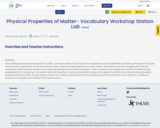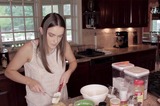
After reading about physical properties of matter, I wanted students to have a chance to experience what the different vocabulary words meant and gain some common experiences so that we would be able to reference these experiences in later classes. My students were also struggling with the new vocabulary words as well as the idea that melting temperature was a physical property. These six stations are designed for students to rotate through independently in small groups. The teacher will be at the gallium melting demonstration station throughout the activity while also monitoring students' progress around the room. At each station students will create a Frayer Model for the vocabulary term that includes the term, definition, a drawing, a synonym, an example, and a sentence that uses the term.
- Subject:
- Science
- Material Type:
- Activity/Lab
- Date Added:
- 12/22/2019
